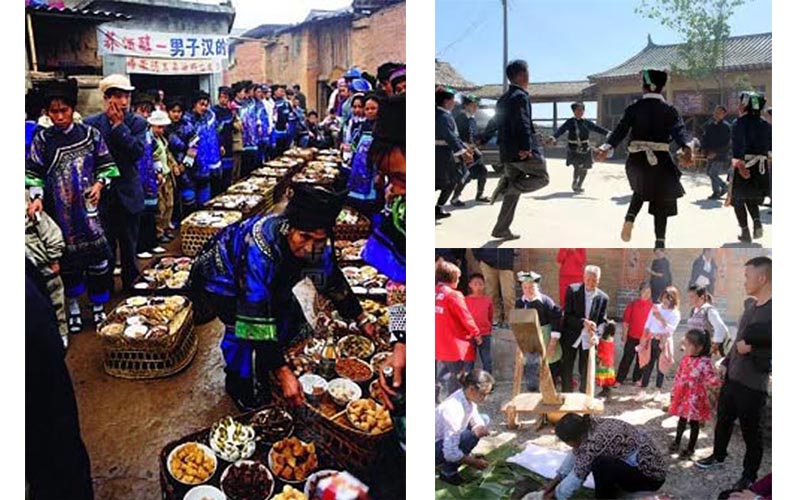 alt="Puer Surrounding Counties and Towns: Weekly & Special Local Markets Travel Guide"
/>
alt="Puer Surrounding Counties and Towns: Weekly & Special Local Markets Travel Guide"
/>
Misuozha Festival of Hani Ethnic Minority
Basic Introduction
- Chinese Name: 哈尼族米索扎节
- English Name: Misuozha Festival of Hani Ethnic Minority
As the festival approaches, the men, women, and children of the Bukun people are all smiles, and everyone changes into festive attire. The young women are particularly eye-catching, dressed in dark blue cloth adorned with embroidered floral patterns in red and green silk threads. A bundle of bright red thread is tied within their headscarves, extending towards their rosy cheeks. They wear garments decorated with silver beads, with an octagonal silver pendant in the center, resembling a blooming white lotus flower. It is said to bring good fortune and ward off disasters! Their lower legs are tightly wrapped in dark blue cloth, fastened with red pom-poms made of yarn.

Festival Customs
On the first day of “Misoza,” at dawn, every household makes rice dumplings (tangyuan) and pounded rice cakes. The sound of pounding rice, “kōng tōng, kōng tōng,” echoes throughout the village. After eating the dumplings and rice cakes, everyone begins to slaughter pigs, chickens, and ducks…
At noon, when the bright sun casts golden light over Bukun village, young men chop six bamboo poles. In an open area at the village entrance, they set up four poles in an equilateral shape, and use two bamboo sticks to form an “X” to serve as crossbeams, with a rope hanging down from the center. A seat cushion is added at the bottom, creating a “swing.” Then, a grand swinging ceremony is held. The host of the ceremony is called the “Moba,” who is elected by the community. The qualifications for a Moba are quite high: they must be over fifty years old, have grandchildren, and be hard-working and frugal. Those with an abnormal death in the family or individuals who are widowed, alone, or lazy cannot be elected.
The ceremony begins with the Moba holding a bowl of glutinous rice dumplings known as “three white and three black” (the black ones are covered in black sesame) and chanting blessings such as “Li na shi mi hei yi ba,” while tossing the black dumplings onto the grass to signify bidding farewell to the old and welcoming the new. He then recites another set of blessings, hoping for the arrival of the New Year. Subsequently, the village guns are fired in unison, and the manggu (a type of drum) sounds, while the Moba pushes the swing ropes upward three times. Everyone, young and old, participates in swinging, as it is said that swinging can ward off disasters and prolong life. Who wouldn’t want such benefits? On the last day of the festival, the Moba repeats the blessings spoken at the beginning, pushes the swing ropes down three times, and cuts the swing rope with a knife, signifying a victorious conclusion. Then, the village youth and children beat drums and gongs as they run to celebrate at each household…
In the evening, a bonfire is lit on the lawn, and everyone brings out tables laden with wine, meat, and fruits. The elders sit on the ground and perform the Alachu (a type of dance), while people dance, sing, and watch, celebrating until dawn, without a moment of sleep.

 7 Days GolfingTour
7 Days GolfingTour
 8 Days Group Tour
8 Days Group Tour
 8 Days Yunnan Tour
8 Days Yunnan Tour
 7 Days Shangri La Hiking
7 Days Shangri La Hiking
 11 Days Yunnan Tour
11 Days Yunnan Tour
 6 Days Yuanyang Terraces
6 Days Yuanyang Terraces
 11 Days Yunnan Tour
11 Days Yunnan Tour
 8 Days South Yunnan
8 Days South Yunnan
 7 Days Tea Tour
7 Days Tea Tour
 8 Days Muslim Tour
8 Days Muslim Tour
 12 Days Self-Driving
12 Days Self-Driving
 4 Days Haba Climbing
4 Days Haba Climbing
 Tiger Leaping Gorge
Tiger Leaping Gorge
 Stone Forest
Stone Forest
 Yunnan-Tibet
Yunnan-Tibet
 Hani Rice Terraces
Hani Rice Terraces
 Kunming
Kunming
 Lijiang
Lijiang
 Shangri-la
Shangri-la
 Dali
Dali
 XishuangBanna
XishuangBanna
 Honghe
Honghe
 Kunming
Kunming
 Lijiang
Lijiang
 Shangri-la
Shangri-la
 Yuanyang Rice Terraces
Yuanyang Rice Terraces
 Nujiang
Nujiang
 XishuangBanna
XishuangBanna
 Spring City Golf
Spring City Golf
 Snow Mountain Golf
Snow Mountain Golf
 Stone Mountain Golf
Stone Mountain Golf












 What Our Customers Say?
What Our Customers Say?
